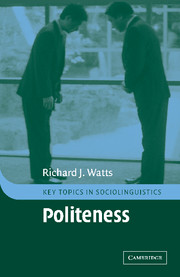Book contents
- Frontmatter
- Contents
- Preface
- 1 Introducing linguistic politeness
- 2 Politeness through time and across cultures
- 3 Modelling linguistic politeness (I)
- 4 Modelling linguistic politeness (II): Brown and Levinson and their critics
- 5 Facework and linguistic politeness
- 6 A social model of politeness
- 7 Structures of linguistic politeness
- 8 Relevance Theory and concepts of power
- 9 Politic behaviour and politeness in discourse
- 10 Politic behaviour and politeness within a theory of social practice
- Notes
- Glossary of terms
- References
- Index
10 - Politic behaviour and politeness within a theory of social practice
Published online by Cambridge University Press: 24 November 2009
- Frontmatter
- Contents
- Preface
- 1 Introducing linguistic politeness
- 2 Politeness through time and across cultures
- 3 Modelling linguistic politeness (I)
- 4 Modelling linguistic politeness (II): Brown and Levinson and their critics
- 5 Facework and linguistic politeness
- 6 A social model of politeness
- 7 Structures of linguistic politeness
- 8 Relevance Theory and concepts of power
- 9 Politic behaviour and politeness in discourse
- 10 Politic behaviour and politeness within a theory of social practice
- Notes
- Glossary of terms
- References
- Index
Summary
EMPIRICAL WORK ON LINGUISTIC POLITENESS
As we saw in chapter 4, work carried out on linguistic politeness following the reprint of Brown and Levinson's work in 1987 can be grouped roughly into five categories: 1. work criticising aspects of the Brown and Levinson model (much of which we dealt with in that chapter); 2. empirical work on particular types of speech activity (the most common of these being requests, apologies, compliments and thanks); 3. cross-cultural work assessing the ways in which two or more cultures differ in their realisations of politeness; 4. the application of politeness models, mainly Brown and Levinson's, to data in other disciplines; 5. sporadic attempts to suggest alternative lines of enquiry into the phenomenon of linguistic politeness. If we had to categorise the present book, it would appear in category 5, but I shall argue in this final chapter that it represents a serious, radical alternative to current theories on the market.
Empirical work on linguistic politeness in categories 2, 3 and 4 makes up the bulk of material since 1987, and much of it has appeared in journals such as the Journal of Pragmatics, Multilingua, the International Journal of the Sociology of Language, Language and Society, etc. It covers such areas as developmental and cognitive psychology, psychotherapy, business and management studies, language teaching, gender studies, law, etc., and the vast majority of this work deals with possible practical applications of politeness theory to the research concerns of these subjects.
- Type
- Chapter
- Information
- Politeness , pp. 250 - 263Publisher: Cambridge University PressPrint publication year: 2003
- 1
- Cited by

